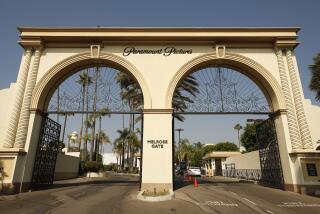DIC, Computer Memories Plan Merger : Cartoon Maker Seeks Easy Way to Go Public
- Share via
DIC, a Burbank company that in six years rose from a two-man operation to become the nation’s largest television cartoon maker, disclosed Monday that it plans to go public by merging with a largely liquidated computer parts company in Chatsworth.
Under the agreement, DIC would in effect absorb Computer Memories, which was one of the nation’s largest makers of disk drive data storage devices for personal computers until it was dumped in 1985 by its primary customer, IBM.
The deal follows the recent collapse of a similar agreement Computer Memories had with Hemdale Film, a Hollywood company that financed the Academy Award-winning movie “Platoon.” Computer Memories’ directors scrapped that merger because of Hemdale’s ongoing legal problems with Vestron Inc. over the videocassette rights to “Platoon.”
Shareholders of Computer Memories, which sold most of its assets and became a shell company last year, are expected to receive about one-third of the stock of the merged firm. The new company’s overall value was placed at $75 million.
“It looks like they are a very nice money-making, cash-generating company,” Computer Memories Chairman Irwin Rubin said of DIC. “It also is in a business that goes on and on and on because children go on and on and on.”
Animating Alf, Heathcliff
After the deal is completed, DIC will be the surviving entity and gain access to the $25 million in cash that Computer Memories holds. The merger also gives DIC a cheap, easy way to go public because it will take on Computer Memories’ status as a publicly held company. Merging with a public shell company generally requires fewer government filings and lower investment banking fees than selling stock through an initial public offering.
DIC President Andy Heyward and other company executives were on vacation Monday and could not be reached for comment.
DIC (pronounced DEEK ) has produced or co-produced six weekly half-hours of programming now airing on Saturday mornings on the three major networks. It has 50 more half-hours of programming distributed through syndication.
The company’s programs feature such characters as Alf, Dennis the Menace and Heathcliff. DIC also has produced such shows as “Inspector Gadget” and “The Real Ghostbusters.” The company has said it expects revenue of about $90 million this year.
In an interview earlier this month, Heyward, 38, who said he controls DIC with a 52% stake, said that he wanted to take the company public in part to help him raise money to finance an ambitious list of plans. Those plans, he said, include developing prime-time family shows, an indoor theme park somewhere in Southern California and a line of boutiques featuring characters from DIC-produced cartoons and toys.
He also acknowledged that the company has considerable debt resulting from the $65-million leveraged buyout he led in December, 1986, with financial help from the Bear, Stearns & Co. brokerage firm and Prudential Insurance.
Former Story Writer
At that time, Heyward and his partners bought the stakes of company founder Jean Chalopin, a French businessman, and Radio-Television Luxembourg, a European firm that backed Chalopin when he started the firm in 1976. Heyward, a former story writer for the Hanna-Barbera cartoon factory, started DIC’s U.S. operations in April, 1982, and built it into an animation powerhouse virtually from scratch, largely by forming alliances with toy makers and greeting card companies.
Beginning at his mother’s kitchen and working with Chalopin, Heyward soon was producing shows based on characters that toy makers could turn into toys. This often made it easier for Heyward to sell his programs to the networks because sponsors were already lined up. And toy makers or greeting card companies often financed DIC shows in exchange for ad time or a share of the profits.
The merger must be approved by Computer Memories shareholders and DIC’s owners.
Computer Memories’ troubles began in August, 1985, when IBM, which accounted for about 80% of the company’s sales at the time, disclosed it was dropping the company as a supplier of hard-disk drives for its IBM-PC AT computer. Within a year, its directors voted to liquidate.





